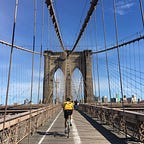Bike sharing in London? Here’s what the data says
Trends in the bike sharing program in London
If you have used your town’s bike share system, you know that there are times when it’s hard to find a bike near you or an empty dock at your destination. Digital apps can help us navigate and find bike stations, but is there anything else we can learn by looking at the data?
As people return to work during the pandemic, individualized, safe, and reliable transportation is becoming more necessary. Given the rise in demand, it’s useful to know what conditions make for busy bike sharing so we can plan our trips accordingly. It’s natural to expect that rush-hour will be the busiest time for bike sharing. Likewise, nice weather is more inviting for commuting by bike, but what does the data indicate?
To uncover trends in the bike share program in London, we analyze the public data from Transport for London (TfL) in 2015 and 2016. The data contained the number of bike shares per hour and information about the time and weather when these took place. At first glance, ridership in London increased by about 4% from 9,738,746 rides in 2015 to 10,129,546 rides in 2016. The upward trend is likely to continue as policies throughout the world are promoting more use of bicycles
What is the best time to bike share in London?
Naturally, there is peak demand for bike shares during rush hours. About 21% of bike shares happen around 8 am and 32% around 5 pm. The increase in demand when people commute to and from work was present throughout the year. And not surprisingly, summer was the busiest season for bike sharing.
During weekends or holidays, bike shares decrease by about 20%. The demand for bikes corresponding to the time the day follows a different pattern to that of weekdays, with most bike shares happening in the middle of the afternoon.
On average, Thursdays are the day with the highest number of bike shares, whereas Sundays are the least busy. The months of June, July and August reported almost twice as many bike shares than December, January, and February
Weather and bike shares
Weather plays a key factor in deciding whether to bike share. As we saw before, summertime bike share records are the highest, but what does the data say about the number of bike shares during different weather conditions?
Not surprisingly, in London, most bike share recordings happen when there are scattered clouds or clear. Interestingly, there are more recordings of people riding when it’s rainy than cloudy.
Londoners were more inclined to bike share when the temperature was near 18 degrees celsius. High humidity didn’t significantly affect their bike sharing use, although there were few bike shares when the humidity was high.
Conclusions
The parameters that have more impact on the bike share demand in London are the temperature and time of the day. Together with the type of day (weekday or weekend), these variables are the most important at predicting the bike share counts in London. The number of bike share rides in London is growing over time. However, more data would shed light on how fast the demand for bike sharing services is increasing.
If you are planning to bike share to work, keep in mind that there’s a high demand around 8 am and 5 pm, so it’s recommended that you plan beforehand. Additionally, if the weather is nice, you might have to walk a few more blocks to find a bike near you. See you on the road! Ring-ring
